There’s nothing impressive about a seven and a half foot tall robot that’s mute. That’s the issue we were having with Sean’s literal diabolus ex machina, the Killbot. Sean had made an impressive robot costume, lit up by yours truly which I covered in a previous post. He’s replete with spikes, claw, glowing brain, and a giant pepper-spray cannon. But his titular song called for the robot to do vocals. Being total nonces when it comes to playing along with a click-track and samples, we were stuck with a voiceless leviathan… and then came along the Electro-Harmonix V256 Vocoder Pedal.
Yes, it’s a tad thrashed. We play “thrash metal,” after all. And when Killbot springs forth from backstage, it is a sight to behold. He towers over us, punches me in the head, sprays the crowd, and it’s even better when he’s got something to say. The V256, released sometime in 2009, was just what we were looking for to complete this part of our act.
Sean and I had talked about his obsession with vocoders many times over the years. In the early days of Impaled, we often quoted that horrible Beck song, “Two Turntables and Microphone,” because we liked the robot voice. It didn’t hurt that the robot kinda looked like Tom Servo Mystery Science Theater 3000. I’m pretty sure that’s what made Sean conceive of the character Killbot… solely to have a vocoded voice on one of his records and give that Scientologist fuck-tard a run for his money. Sean bought one of these.
For 2003’s “Maniaxe,” and the 2006 follow-up, “Splatterthrash,” this Korg Mircokorg synth and vocoder worked great. Killbot, the character, had a voice and it sounded cool. Then our live show started to expand. The robot antagonist existed in real time. We used the Microkorg live a couple times, but what a pain in the ass. We had to patch it in to the soundboard and then find someone capable of playing the keys and speak into it as we were busy thrashing on stage. Eventually we gave up trying to have the voice and Sean just screamed the parts. Sometime in 2010, I came across the EHX V256 Vocoder online and a solution was found.
Bloodied and beaten after one of our stage shows, this pedal keeps working. It has a bunch of other functions besides vocoding, but fuck ’em, they sound like lame nu-jazz wanna-be talk box shit to me. Nobody needs to hear us sounding like we’ve been auto-tuned to a guitar playing through this pedal. Hell, no one needs to hear that from ANYONE. It’s also got a phantom power switch (never needed it), Midi-input (never used it), transpositions, reflex tune, a whole mess of things I wish weren’t there. It has three programmable presets for vocoder and if God were real, it would have six more.
The pedal does add considerable gain to the signal, much to the chagrin of most live sound technicians. As soon as you tell them you’re plugging in a pedal to the microphones, they generally freak out, anyway. Don’t worry, you god damned old codger… this pedal is actually MADE as a vocal effect, complete with a balanced line through. There’s a whole new world out there of effects past when you roadied for Warrant.
I assume the additional gain is to even out the effected signal with the bypassed one. Going through a standard Shure SM58, we always have to tell the house sound guy to turn the gain on the mixer all the way down before we plug in. It also has a high gain switch you can employ, but I can’t imagine why. Maybe if you were singing through a low gain Shure SM7 or something, but who would do that live? After the switch snapped, I removed it from the circuit board and that leaves the pedal permanently on lo-gain: just fine for us.
It has a pitch shifter, but before you think we’re gonna start covering tunes off of “Reek of Putrefaction,” it’s not good for that. It’s more of a synthesizer tuner, along with the pitch and tone knobs, to get a good vocoder drone. The way a vocoder works is to simplify the human voice by passing it through a narrow band of frequencies, filter those waves into electronic commands, then playback the commands like some kind of player-piano reel into a synthesizer (basically). It was originally used to encrypt and lower the bandwidth of transmitted speech as early as during World War 2. Now it voices the robot in a shock-rock band. How far we’ve come…
With three programmable presets, we’re able to cycle through up to four tones (including the non-preset knob layout) in the V256. We matched the key pretty closely to the original Microkorg recordings using just the knobs and it sounds a little something like this… take it away, Killbot.
The Microkorg comes out ahead as a vocoder and we’ll continue to use it for recording. The EHX V256 Vocoder is a bad ass in its own right, however, as a compact stomp box for live use. With a price point almost half that of the Microkorg, the V256 is more affordable for poor musicians to fuck around with for home recording, but also sounds good enough for any professional studio. It won’t run on batteries, but it does accept standard barrel-style 9V adapters such as the Visual Sounds 1-Spot, so long as it gets at least 200mA.
Electro-Harmonix really innovated with this pedal; the first ever vocoder stomp box, as far as I know. Kudos for applying so much R&D; to an effect that has so little broad appeal, but is so infinitely awesome.

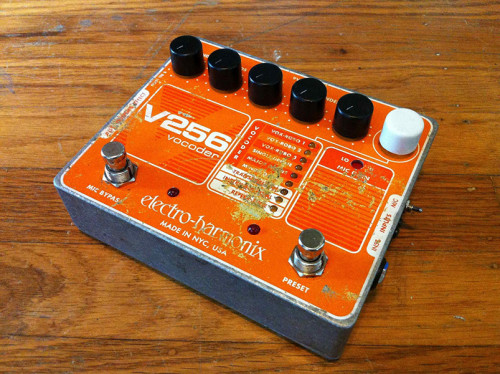
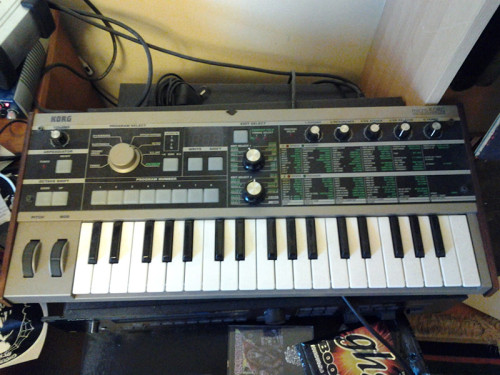
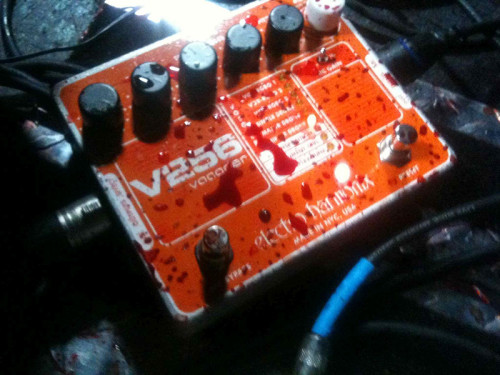
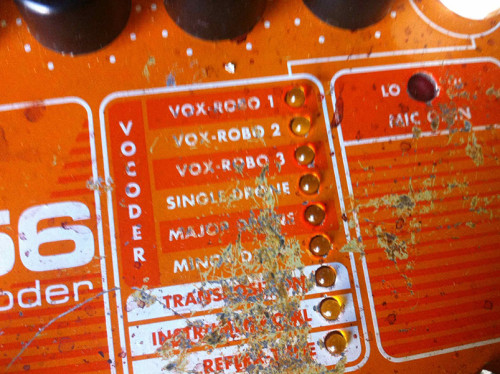
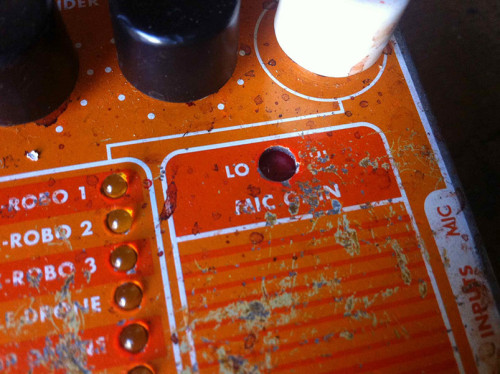
EHX also makes the Voice Box (http://www.ehx.com/products/voice-box). It can do similar stuff… synth, harmonies, and reverb. Just putting it out there as another option. My old band used one on a few tunes, it worked well for us (you can hear it at http://music.wormrider.com/track/assembling-to-await-the-eschaton-2 – fast forward to the 1:50 mark).
Not quite robot, but that's a delicious '70s vibe to that vocal effect. Makes me think I'm going to have some evil green ball menace me by telling me some weird stories.
Hello. I’m from the future. Great article.